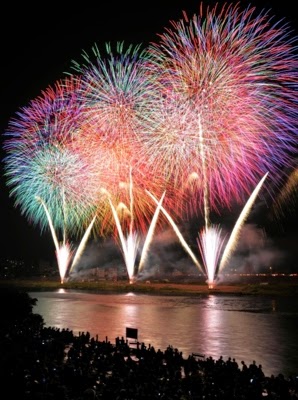Cormorant Fishing or
ukai in Japanese is a major summer attraction on the Nagara River in Gifu City, Gifu Prefecture, Japan. Ukai is a traditional fishing method that uses trained cormorants to catch river fish. The art has been practiced along the Nagara River in Gifu for more than 1300 years. It has a very long history in Japan and is mentioned in many ancient chronicles. The samurai warlord Oda Nobunaga took the ukai fisherman under his patronage and created the official position and title of
usho (Cormorant Fishing Master). The Shogun Tokugawa Ieyasu, enjoyed watching ukai when he visited Gifu City and also gave his patronage and protection to the art. He was so fond of the sweetfish he had it delivered to Edo Castle in modern day Tokyo. Today the fishing masters are the official fisherman of the emperor of Japan.
 |
| Picture depicting the Cormorant Fishing |
Cormorant fishing takes place at night in the darkness. It begins with six long, wooden boats, each manned by a master fisherman and two boatmen, who propel the boat downstream with long wooden poles. The fishermen are dressed in traditional costume of straw skirt, sandals and black kimono. They use the flames of the
kagari-bi (fire lanterns) which reflect of the surface of the river to attract the fish. The fishing masters
usho use cormorants
u to catch the fish as they come to the surface. The cormorants dive underwater to catch the fish by swallowing them whole. A special snare around the neck of the bird prevents them from eating the fish, which are kept in the cormorant’s throat and are retrieved later. The fish are
ayu or sweetfish and are very tasty.
It is spectacular to watch and is made even more beautiful by having Mt Kinka and Gifu Castle as a background to the scene.
 |
| Cormorant Fishing Viewing Boat |
The Usho Fishing Masters
There are six Cormorant Fishing Masters on the Nagara River in Gifu City. The title and occupation are inherited and are passed down from generation to generation. Their lives are dedicated to cormorant fishing and the skills and techniques used are honed over many years. They lovingly care and raise their cormorants all year round and take great pride in them.
 |
| Bronze Statue of a Fishing Master |
The Cormorants
The cormorants are migratory birds and are captured in the wild and trained by the fishing masters to grow into fishing cormorants.
 |
| Manhole Cover in Gifu City featuring the famous Cormorants |
Where to see Cormorant Fishing in Gifu City
You can view the cormorant fishing free from the banks of the Nagara River east of the Nagarabashi bridge, or for a closer view, from one of the many viewing boats. The boats range in size from 15-50 passengers.
The Ukai season is from May 11 to October 15 and usually start from 7:30 pm. Boats depart nightly (except after flooding or on the night of the harvest moon) from the Nagarabashi bridge.
You can purchase tickets at the Cormorant Fishing Viewing Boat Office at 1-2 Minato-machi Gifu City.
For more information and fishing schedules, visit the tourist information office in Gifu station or the Cormorant Fishing Viewing Boat Office.
There are some spectacular fireworks to celebrate the opening of the Cormorant Fishing Season on May 11th.
 |
| Cormorant Fishing Viewing Boat Office |
How to Get There
From JR Gifu Station take a Gifu Bus heading towards the Nagara area and get off at the Nagarabashi bus stop. It takes around 15 minutes.
View Larger Map
Website:
http://www.gifucvb.or.jp/en/01_sightseeing/01_01.html


































